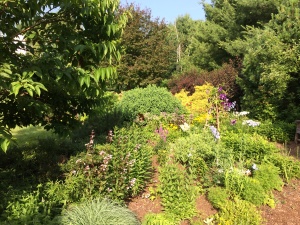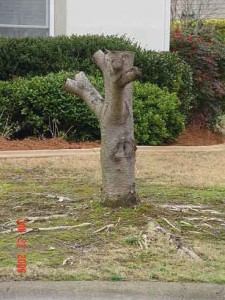Welcome to “Out in the Garden,” my bi-weekly newsletter featuring stories of life in my garden. I hope my stories will delight, inform, and provoke my readers. Please let me know if they do. And please share my newsletter with any others whom you think might enjoy it.
Our relationship to plants is fundamental to our well-being on this planet, yet we often treat plants very badly. I hope that in a small way my stories might help to put us as humans in a better relationship with plants. As a gardener, I learn a lot from plants about what it means to be a person, but I also learn a lot about the larger world that is not human. To be out in the garden is, for me, a joy and a journey.
The title of my newsletter (and memoir in process) comes from a column I wrote a few years ago for Community, the newspaper of the Capital District Pride Center. I called the column “Out in the Garden” to play on the two meanings of “out” relevant to the context – out of the house and out of the closet. But it is actually rather difficult to be “out” in the garden as a lesbian. Does one say to the neighbor passing by and asking a question about a particular plant, “Why, yes, that is a dwarf lilac and as a lesbian I find it a very useful plant for the small garden.” Or perhaps when giving a talk on Lower-Maintenance Gardening I might say, “Speaking as a lesbian, I think it important to point out that lower maintenance plants have many of the characteristics we associate with weeds.” Unlikely, so for now I will tell about the other meaning of “out” and its roots, which go deep.
I got my love of gardening from my mother. She got her love of gardening from her father. She worshipped her father. Coming home from school, she would ask her mother, “Where is Dad,” and the answer was always, “Out in the garden, dear.” My grandfather emigrated from Ireland as a young boy but all his life he treasured the memory of his mother, another gardener. My gardening lineage goes back to a cottage in Ireland.
My passion for being outside goes back to my infancy when, according to my mother, I could always be counted on to sleep deeply in my baby buggy outside on the back porch. I evidently expressed my passion for being outside as soon as I could talk. “Out” was one of my first words, and one of my first sentences conveyed the message, “I go out now.” My mother told me she could not keep shoes or socks on my feet or me inside.
Here I am, so many years later, still going out, but now of course with feet well protected by good boots and sweat-absorbing socks. Unlike the claim made by politicians and rarely fulfilled that “everything changes on day 1,” for me there is a day when everything really does change and I become a gardener again. I am out in the garden on April 1, come rain or sun or even snow. And I stay out until the end of November when darkness and the increasing cold finally force me inside. I am out early in the morning and late in the afternoon and any time in between that is possible before the heat makes it impossible or other obligations claim me.
I garden in upstate New York’s Capital District, on a corner lot that occupies 2/3rds of an acre. I have been here 23 years and by now I have improved the original clay soil sufficiently so that I can grow a wide variety of plants that are adaptable to my climate. I suffer from Zone Envy from time to time, wanting that lovely zone 6 plant palette, but I have made my peace with my zone 5 site, and besides it is getting warmer.
My large garden is composed of several smaller gardens and I try to keep track of them by giving them memorable names. The oval garden that stretches along the back of the property in front of the line of blue spruces is called, for example, “the grim reaper garden.” Its focal point is a weeping Norway spruce, gift of my dear friend Susan. Over the years I have trained this plant to grow up for 6’ before it starts to weep down. To me it most resembles a Hawaiian dancer, with arms out to the side and body slightly bent at the knees, moving gently from side to side. But Sara, my vegetable gardening partner, says it looks much more like the grim reaper with his scythe of doom. Her name has stuck.
Ironically, the pandemic with its protocol to shelter in place has given me the chance to be out in my garden on a daily basis for the first time since I moved to Columbine Drive and began to create my garden. For several years Perennial Wisdom, my small perennial garden design business, took up most of my week and my work as an Albany County Master Gardener took up the rest of it, leaving me only Saturday to be in my own garden.
Seeing my garden every day, I have begun to notice details missed before. The iris desperately need dividing. They present masses of upheaved roots, hard-packed from years of neglect and sparsely blooming as a result. A morning’s work has seen them dug up, cleaned off, divided, and replanted in better locations. The potentillas desperately need thinning. Who knew? Looking closely now, I see and do. I am actually on top of the thistles and the Japanese bittersweet, for now.
For me, then, there is a green lining to the prohibition on leaving home. Noticing has become my job. Yesterday, I took a good look at one of my columbines, flourishing in the front shade garden under the river birch. Did it need to be so beautiful, I wondered, to do its job of reproducing itself? It seemed like a gift, the exquisite generosity of nature. Indeed, I could not help but wonder, what immortal hand or eye framed its gorgeous symmetry.
There is so much news to share. Stay tuned for more.

